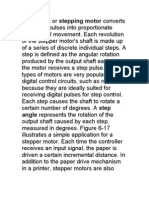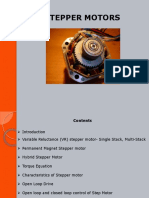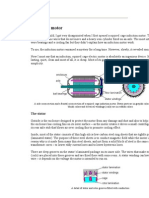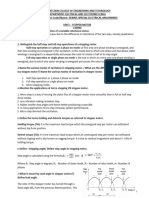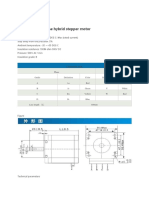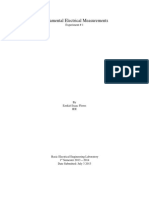Stepper Motor Characteristics
Uploaded by
satyabannayakStepper Motor Characteristics
Uploaded by
satyabannayakINTRODUCTION
A stepper motor (or step motor) is a brushless, synchronous electric Motor that
can divide a full rotation into a large number of steps. The motor's position can be
controlled precisely without any feedback mechanism, as long as the motor is
carefully sized to the application. Stepper motors are similar to switched reluctance
motors (which are very large stepping motors with a reduced pole count, and
generally are closed-loop commutated.)
Stepper motors operate differently from DC brush motors, which
rotate when voltage is applied to their terminals. Stepper motors, on the other hand,
effectively have multiple "toothed" electromagnets arranged around a central gear-
shaped piece of iron. The electromagnets are energized by an external control circuit,
such as a microcontroller. To make the motor shaft turn, first one electromagnet is
given power, which makes the gear's teeth magnetically attracted to the
electromagnet's teeth. When the gear's teeth are thus aligned to the first
electromagnet, they are slightly offset from the next electromagnet. So when the next
electromagnet is turned on and the first is turned off, the gear rotates slightly to
align with the next one, and from there the process is repeated. Each of those slight
rotations is called a "step", with an integer number of steps making a full rotation. In
that way, the motor can be turned by a precise angle.
STEPPER MOTOR CHARACTERISTICS
Stepper motors are rugged and inexpensive because the rotor contains
no winding slip rings, or commutator. The rotor is a cylindrical solid, which may
also have either salient poles or fine teeth. More often than not the rotor is a
permanent magnet. Determine that the rotor is a permanent magnet by unpowered
hand rotation showing detent torque, torque pulsations. Stepper motor coils are
wound within a laminated stator, except for can stack construction. There may be as
few as two winding phases or as many as five. These phases are frequently split into
pairs. Thus, a 4-pole stepper motor may have two phases composed of in-line pairs
of poles spaced 90o apart. There may also be multiple pole pairs per phase. For
example a 12-pole stepper has 6-pairs of poles, three pairs per phase.
Since stepper motors do not necessarily rotate continuously, there
is no horsepower rating. If they do rotate continuously, they do not even approach a
sub-fractional hp rated capability. They are truly small low power devices compared
to other motors. They have torque ratings to a thousand in-oz (inch-ounces) or ten n-
m (Newton-meters) for a 4 kg size unit. A small “dime” size stepper has a torque of a
hundredth of a Newton-meter or a few inch-ounces. Most steppers are a few inches
in diameter with a fraction of a n-m or a few in-oz torque. The torque available is a
function of motor speed, load inertia, load torque, and drive electronics as illustrated
on the speed vs. torque curve. (Figure below) An energized, holding stepper has a
relatively high holding torque rating. There is less torque available for a running
motor, decreasing to zero at some high speed. This speed is frequently not attainable
due to mechanical resonance of the motor load combination.
Summary
Stepper motors are constant power devices.
As motor speed increases, torque decreases.
Motors with a greater number of phases also exhibit smoother operation than
those with fewer phases.
The torque curve may be extended by using current limiting drivers and
increasing the driving voltage.
Steppers exhibit more vibration than other motor types, as the discrete step
tends to snap the rotor from one position to another (called a detent). The
vibration makes stepper motors noisier than DC motors.
The effect can be mitigated by accelerating quickly through the problem
speeds range, physically damping (frictional damping) the system, or using
a micro-stepping driver.
TYPES
There are three main types of stepper motors.
Permanent Magnet Stepper
Hybrid Synchronous Stepper
Variable Reluctance Stepper
Permanent magnet stepper:-
A permanent magnet stepper motor has a cylindrical permanent magnet
rotor. The stator usually has two windings. The windings could be centre tapped to
allow for a unipolar driver circuit where the polarity of the magnetic field is changed
by switching a voltage from one end to the other of the winding. A bipolar drive of
alternating polarity is required to power windings without the centre tap. A pure
permanent magnet stepper usually has a large step angle. Rotation of the shaft of a
de-energized motor exhibits detent torque. If the detent angle is large, say 7.5 o to 90o,
it is likely a permanent magnet stepper rather than a hybrid stepper (next
subsection).
Permanent magnet stepper motors require phased alternating
currents applied to the two (or more) windings. In practice, this is almost always
square waves generated from DC by solid state electronics. Bipolar drive is square
waves alternating between (+) and (-) polarities, say, +2.5 V to -2.5 V. Unipolar drive
supplies a (+) and (-) alternating magnetic flux to the coils developed from a pair of
positive square waves applied to opposite ends of a centre tapped coil. The timing of
the bipolar or unipolar wave is wave drive, full step, or half step.
Wave drive:-
PM wave drive sequence (a) ?1+ , (b) ?2+ , (c) ?1- , (d) ?2-.
Permanent magnet stepper motors are manufactured with various lead-wire
configurations. (Figure below)
(Stepper motor wiring diagrams)
Construction:-
The construction of a permanent magnet stepper motor is
considerably different from the drawings above. It is desirable to increase the
number of poles beyond that illustrated to produce a smaller step angle. It is also
desirable to reduce the number of windings, or at least not increase the number of
windings for ease of manufacture.
Permanent magnet stepper motor, 24-pole can-stack construction.
The permanent magnet stepper (Figure above) only has two windings, yet has 24-
poles in each of two phases. This style of construction is known as can stack. A phase
winding is wrapped with a mild steel shell, with fingers brought to the centre. One
phase, on a transient basis, will have a north side and a south side. Each side wraps
around to the centre of the doughnut with twelve interdigitated fingers for a total of
24 poles. These alternating north-south fingers will attract the permanent magnet
rotor. If the polarity of the phase were reversed, the rotor would jump 360 o/24 = 15o.
We do not know which direction, which is not useful. However, if we energize?-1
followed by?-2, the rotor will move 7.5 o because the?-2 is offset (rotated) by
7.5o from?-1. See below for offset. And, it will rotate in a reproducible direction if the
phases are alternated. Application of any of the above waveforms will rotate the
permanent magnet rotor.
Note that the rotor is a gray ferrite ceramic cylinder magnetized in the 24-pole
pattern shown. This can be viewed with magnet viewer film or iron filings applied
to a paper wrapping. Though, the colours will be green for both north and south
poles with the film.
(a) External view of can stack, (b) field offset detail.
Can-stack style construction of a PM stepper is distinctive and easy to identify by the
stacked “cans”. (Figure above) Note the rotational offset between the two phase
sections. This is key to making the rotor follow the switching of the fields between
the two phases.
Summary: permanent magnet stepper motor
The rotor is a permanent magnet, often a ferrite sleeve magnetized with
numerous poles.
Can-stack construction provides numerous poles from a single coil with
interleaved fingers of soft iron.
Large to moderate step angle.
Often used in computer printers to advance paper.
Hybrid stepper motor:-
The hybrid stepper motor combines features of both the
variable reluctance stepper and the permanent magnet stepper to produce a
smaller step angle. The rotor is a cylindrical permanent magnet, magnetized
along the axis with radial soft iron teeth (Figure below). The stator coils are
wound on alternating poles with corresponding teeth. There are typically two
winding phases distributed between pole pairs. This winding may be center
tapped for unipolar drive. The centre tap is achieved by a bifilar winding, a
pair of wires wound physically in parallel, but wired in series. The north-
south poles of a phase swap polarity when the phase drive current is
reversed. Bipolar drive is required for un-tapped windings.
( Hybrid stepper motor)
The above drawing is representative of an actual hybrid stepper motor. However,
we provide a simplified pictorial and schematic representation (Figure below) to
illustrate details not obvious above. Note the reduced number of coils and teeth in
rotor and stator for simplicity. In the next two figures, we attempt to illustrate the
quarter tooth rotation produced by the two stator phases offset by a quarter tooth,
and the rotor half tooth offset. The quarter tooth stator offset in conjunction with
drive current timing also defines direction of rotation.
(Hybrid stepper motor schematic diagram)
Features of hybrid stepper schematic (Figure above)
The top of the permanent magnet rotor is the South Pole, the bottom north.
The rotor north-south teeth are offset by half a tooth.
If the?-1 stator is temporarily energized north top, south bottom.
The top?-1 stator teeth align north to rotor top south teeth.
The bottom?-1' stator teeth align south to rotor bottom north teeth.
Enough torque applied to the shaft to overcome the hold-in torque would
move the rotor by one tooth.
If the polarity of?-1 were reversed, the rotor would move by one-half tooth,
direction unknown. The alignment would be south stator top to north rotor
bottom, north stator bottom to south rotor.
The?-2 stator teeth are not aligned with the rotor teeth when?-1 is energized.
In fact, the?-2 stator teeth are offset by one-quarter tooth. This will allow for
rotation by that amount if?-1 is de-energized and?-2 energized. Polarity of?-1
and drive determines direction of rotation.
Hybrid stepper motor rotation sequence.
Summary: hybrid stepper motor
The step angle is smaller than variable reluctance or permanent magnet
steppers.
The rotor is a permanent magnet with fine teeth. North and south teeth are
offset by half a tooth for a smaller step angle.
The stator poles have matching fine teeth of the same pitch as the rotor.
The stator windings are divided into no less than two phases.
The poles of one stator windings are offset by a quarter tooth for an even
smaller step angle.
Variable reluctance stepper:-
You might also like
- Study of a reluctance magnetic gearbox for energy storage system applicationFrom EverandStudy of a reluctance magnetic gearbox for energy storage system application1/5 (1)
- Utkal Non Woven Fabric Bag Manufacturing Process Flow Non Woven FabricNo ratings yetUtkal Non Woven Fabric Bag Manufacturing Process Flow Non Woven Fabric1 page
- WE-386398 - R0 - 13.8kV Relay Setting Calculation100% (1)WE-386398 - R0 - 13.8kV Relay Setting Calculation80 pages
- Stepper Motors: Stepper Motor vs. Servo Motor100% (1)Stepper Motors: Stepper Motor vs. Servo Motor13 pages
- Cylindrical Construction: (A) Outside Rotor, (B) Inside Rotor.cNo ratings yetCylindrical Construction: (A) Outside Rotor, (B) Inside Rotor.c4 pages
- Single Phase Induction Motor and Stepper MotorNo ratings yetSingle Phase Induction Motor and Stepper Motor11 pages
- Stepper Motor: From Wikipedia, The Free EncyclopediaNo ratings yetStepper Motor: From Wikipedia, The Free Encyclopedia42 pages
- 8085 - Lecture - Stepper Motor Interfacing - Prof. RAMNo ratings yet8085 - Lecture - Stepper Motor Interfacing - Prof. RAM6 pages
- Pages From Switched Reluctance Motor PDFNo ratings yetPages From Switched Reluctance Motor PDF10 pages
- 185 - EE8005, EE6703 Special Electrical Machines - Question BankNo ratings yet185 - EE8005, EE6703 Special Electrical Machines - Question Bank15 pages
- Induction, Squirrel Cage Motor - Torque Calculation100% (1)Induction, Squirrel Cage Motor - Torque Calculation10 pages
- EE 6504 Electrical Machines-II Mrs.P.Priyadharshini, AP/RMDEEENo ratings yetEE 6504 Electrical Machines-II Mrs.P.Priyadharshini, AP/RMDEEE37 pages
- Construction Operation and Basic Control of VR, PM and Hybrid Type Stepper MotorsNo ratings yetConstruction Operation and Basic Control of VR, PM and Hybrid Type Stepper Motors5 pages
- Q& A EE8005 Special Electrical MachinesNo ratings yetQ& A EE8005 Special Electrical Machines105 pages
- Stepper Motor Operation & C Language Program CodeNo ratings yetStepper Motor Operation & C Language Program Code16 pages
- A New System of Alternating Current Motors and Transformers and Other EssaysFrom EverandA New System of Alternating Current Motors and Transformers and Other Essays5/5 (1)
- Home-made Toy Motors: A practical handbook giving detailed instructions for building simple but operative electric motorsFrom EverandHome-made Toy Motors: A practical handbook giving detailed instructions for building simple but operative electric motorsNo ratings yet
- Statement Showing Minimum Support Prices - Fixed by Government (Rs - Quintal)No ratings yetStatement Showing Minimum Support Prices - Fixed by Government (Rs - Quintal)3 pages
- Curriculum Vitae: Satyaban Nayak Mobile-+919556625688 E-MailNo ratings yetCurriculum Vitae: Satyaban Nayak Mobile-+919556625688 E-Mail3 pages
- Structural and Magnetic Instability of Bilayer and Trilayer Zigzag Graphene NanoribbonsNo ratings yetStructural and Magnetic Instability of Bilayer and Trilayer Zigzag Graphene Nanoribbons6 pages
- Electric Drives - DC Motors (Description and Applications) : Brushed (Field Energised) Motors (Motors Using Wound Rotors)No ratings yetElectric Drives - DC Motors (Description and Applications) : Brushed (Field Energised) Motors (Motors Using Wound Rotors)6 pages
- Spontaneous Magnetization in Heterometallic Nife-Mof-74 Microporous Magnets by Controlled Iron DopingNo ratings yetSpontaneous Magnetization in Heterometallic Nife-Mof-74 Microporous Magnets by Controlled Iron Doping7 pages
- Units Associated With Basic Electrical Quantity100% (1)Units Associated With Basic Electrical Quantity4 pages
- The History of Electrostatic GeneratorsNo ratings yetThe History of Electrostatic Generators10 pages
- Electric Machines:: Project 1 Lap and Wave WindingsNo ratings yetElectric Machines:: Project 1 Lap and Wave Windings9 pages
- 414 - PR 18-9 - The London Equation and The Meissner EffectNo ratings yet414 - PR 18-9 - The London Equation and The Meissner Effect2 pages
- 02 Introduction To Motor Control SystemNo ratings yet02 Introduction To Motor Control System32 pages
- The Application of Landau's Theory of Continuous Phase Transitions To Magnetic Phase TransitionsNo ratings yetThe Application of Landau's Theory of Continuous Phase Transitions To Magnetic Phase Transitions14 pages
- Repair Parts For 100-C / 100L-C / 100Q-C / 100S-C / 104-C / 104S-C ContactorsNo ratings yetRepair Parts For 100-C / 100L-C / 100Q-C / 100S-C / 104-C / 104S-C Contactors3 pages
- Performance Improvement of Magnetic Gear and Efficiency Comparison With Conventional Mechanical GearNo ratings yetPerformance Improvement of Magnetic Gear and Efficiency Comparison With Conventional Mechanical Gear4 pages
- Electrical Engineering Question and Answer - POWER SYSTEM QUESTION and ANSWERNo ratings yetElectrical Engineering Question and Answer - POWER SYSTEM QUESTION and ANSWER4 pages
- DC Motor: Figure 1: Jedlik's "Electromagnetic Self-Rotor"No ratings yetDC Motor: Figure 1: Jedlik's "Electromagnetic Self-Rotor"7 pages
- Fundamental Electrical Measurements: Experiment # 1No ratings yetFundamental Electrical Measurements: Experiment # 18 pages
- Mathematical Model of The Linear Motor: E. Matkevičius, L. RadzevičiusNo ratings yetMathematical Model of The Linear Motor: E. Matkevičius, L. Radzevičius4 pages
- Magnetic Resonance: Compiled and Written By: Faith Van Nice 1992, Mark Haig Khachaturian 2002No ratings yetMagnetic Resonance: Compiled and Written By: Faith Van Nice 1992, Mark Haig Khachaturian 200284 pages
- Study of a reluctance magnetic gearbox for energy storage system applicationFrom EverandStudy of a reluctance magnetic gearbox for energy storage system application
- Utkal Non Woven Fabric Bag Manufacturing Process Flow Non Woven FabricUtkal Non Woven Fabric Bag Manufacturing Process Flow Non Woven Fabric
- Cylindrical Construction: (A) Outside Rotor, (B) Inside Rotor.cCylindrical Construction: (A) Outside Rotor, (B) Inside Rotor.c
- Stepper Motor: From Wikipedia, The Free EncyclopediaStepper Motor: From Wikipedia, The Free Encyclopedia
- 8085 - Lecture - Stepper Motor Interfacing - Prof. RAM8085 - Lecture - Stepper Motor Interfacing - Prof. RAM
- 185 - EE8005, EE6703 Special Electrical Machines - Question Bank185 - EE8005, EE6703 Special Electrical Machines - Question Bank
- Induction, Squirrel Cage Motor - Torque CalculationInduction, Squirrel Cage Motor - Torque Calculation
- EE 6504 Electrical Machines-II Mrs.P.Priyadharshini, AP/RMDEEEEE 6504 Electrical Machines-II Mrs.P.Priyadharshini, AP/RMDEEE
- Construction Operation and Basic Control of VR, PM and Hybrid Type Stepper MotorsConstruction Operation and Basic Control of VR, PM and Hybrid Type Stepper Motors
- A New System of Alternating Current Motors and Transformers and Other EssaysFrom EverandA New System of Alternating Current Motors and Transformers and Other Essays
- Home-made Toy Motors: A practical handbook giving detailed instructions for building simple but operative electric motorsFrom EverandHome-made Toy Motors: A practical handbook giving detailed instructions for building simple but operative electric motors
- Statement Showing Minimum Support Prices - Fixed by Government (Rs - Quintal)Statement Showing Minimum Support Prices - Fixed by Government (Rs - Quintal)
- Curriculum Vitae: Satyaban Nayak Mobile-+919556625688 E-MailCurriculum Vitae: Satyaban Nayak Mobile-+919556625688 E-Mail
- Structural and Magnetic Instability of Bilayer and Trilayer Zigzag Graphene NanoribbonsStructural and Magnetic Instability of Bilayer and Trilayer Zigzag Graphene Nanoribbons
- Electric Drives - DC Motors (Description and Applications) : Brushed (Field Energised) Motors (Motors Using Wound Rotors)Electric Drives - DC Motors (Description and Applications) : Brushed (Field Energised) Motors (Motors Using Wound Rotors)
- Spontaneous Magnetization in Heterometallic Nife-Mof-74 Microporous Magnets by Controlled Iron DopingSpontaneous Magnetization in Heterometallic Nife-Mof-74 Microporous Magnets by Controlled Iron Doping
- Electric Machines:: Project 1 Lap and Wave WindingsElectric Machines:: Project 1 Lap and Wave Windings
- 414 - PR 18-9 - The London Equation and The Meissner Effect414 - PR 18-9 - The London Equation and The Meissner Effect
- The Application of Landau's Theory of Continuous Phase Transitions To Magnetic Phase TransitionsThe Application of Landau's Theory of Continuous Phase Transitions To Magnetic Phase Transitions
- Repair Parts For 100-C / 100L-C / 100Q-C / 100S-C / 104-C / 104S-C ContactorsRepair Parts For 100-C / 100L-C / 100Q-C / 100S-C / 104-C / 104S-C Contactors
- Performance Improvement of Magnetic Gear and Efficiency Comparison With Conventional Mechanical GearPerformance Improvement of Magnetic Gear and Efficiency Comparison With Conventional Mechanical Gear
- Electrical Engineering Question and Answer - POWER SYSTEM QUESTION and ANSWERElectrical Engineering Question and Answer - POWER SYSTEM QUESTION and ANSWER
- DC Motor: Figure 1: Jedlik's "Electromagnetic Self-Rotor"DC Motor: Figure 1: Jedlik's "Electromagnetic Self-Rotor"
- Fundamental Electrical Measurements: Experiment # 1Fundamental Electrical Measurements: Experiment # 1
- Mathematical Model of The Linear Motor: E. Matkevičius, L. RadzevičiusMathematical Model of The Linear Motor: E. Matkevičius, L. Radzevičius
- Magnetic Resonance: Compiled and Written By: Faith Van Nice 1992, Mark Haig Khachaturian 2002Magnetic Resonance: Compiled and Written By: Faith Van Nice 1992, Mark Haig Khachaturian 2002




















